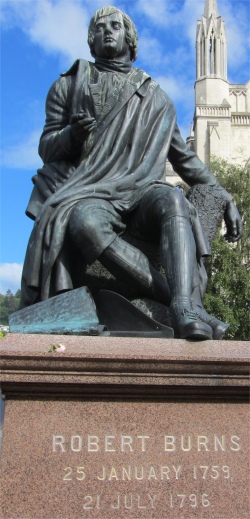
Robbie Burns
|
Despite the rain through the night, I arose to find sunny skies. In quick order it was shower, breakfast and down to the city centre.
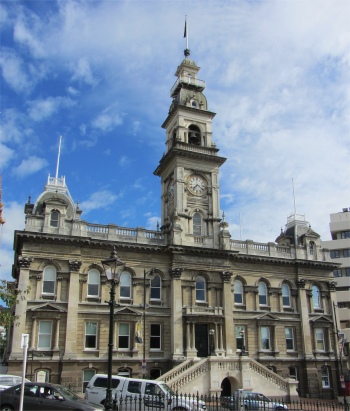
Municipal Chambers
|
I parked in the Octagon area of the city, which for all intents and purposes was bang in the centre. Twelve hours parking in the city centre costs the same as two hours parking in Ipswich. As I made my way out of the car park, the middle-aged Kiwi chap behind me spotted a recent trail of blood on the concrete floor. "There's been a spot of trouble, no doubt," he said. "Oh, is Dunedin subject to violent tendencies?" I asked. "Well ....," he hesitated, "it is not as bad as Christchurch, where my son lives." He didn't elaborate. Our conversation veered off in the Christchurch direction, and he had firm views that redevelopment in Christchurch should be steered towards the Riccarton district rather than the CBD.
"There are big issues looming regarding the building of properties in Christchurch," he said. "The insurance companies now just hold their hands up and back off. They are not interested in insuring properties until about three years after the aftershocks have stopped, and the aftershocks could last up to four years. It is going to be a long drawn out affair. Even our insurance premiums down here are being hiked up." he added. I could see the dilemma.
He wished me good day and carried on with his briefcase to his place of work, and I walked to the visitor centre to book myself onto a guided walking tour. As well as the elderly lady with a bright smile and a twinkle in her eyes who was our guide, there was a young woman from Melbourne, and an Irish woman who now lived in Australia. Her husband had taken their three kids to Cadbury's chocolate factory in town while she could have her culture fix.
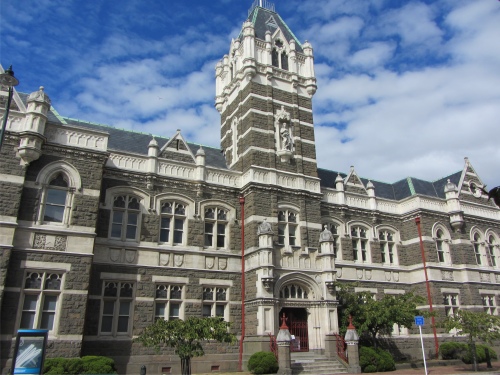
The Courts
|
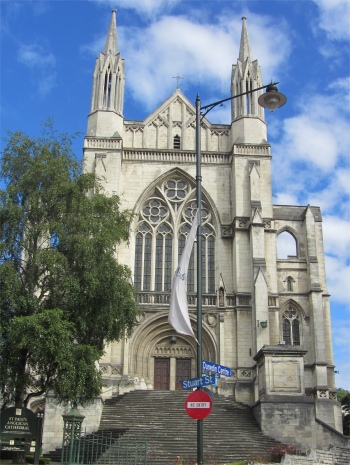
St Paul's Cathedral
|
We made our way to the heart of the city, not a square but The Octagon, an oasis of well-tended lawns and rank and file trees bounded by a blend of well-preserved buildings. Way back in time it had been a rubbish dump, and a cattle market, with stables and fire station on the periphery. Lord of the manor here was a statue of Robbie Burns, with his back to the kirk (St Paul's Cathedral) and his face to the pub. The Octagon was dominated by the 1880 Municipal Chambers, a grand classical affair constructed out of contrasting volcanic bluestone and limestone, with a clock tower which always gave the time as 07:20. Adjacent, the magnificent St Paul's Cathedral was constructed from the same materials. Other notable buildings around the octagon were the Dunedin Public Art Gallery, reportedly the first in the country, the New Zealand Film Archive, and the Regent Theatre. The theatre had at one time been a cinema. However, as TV took customers away from the big screen, it was threatened with closure and redevelopment. Then somebody discovered a large stage behind the cinema screen, and it took on a new lease of life. The interior was based on that of a theatre in Brighton.
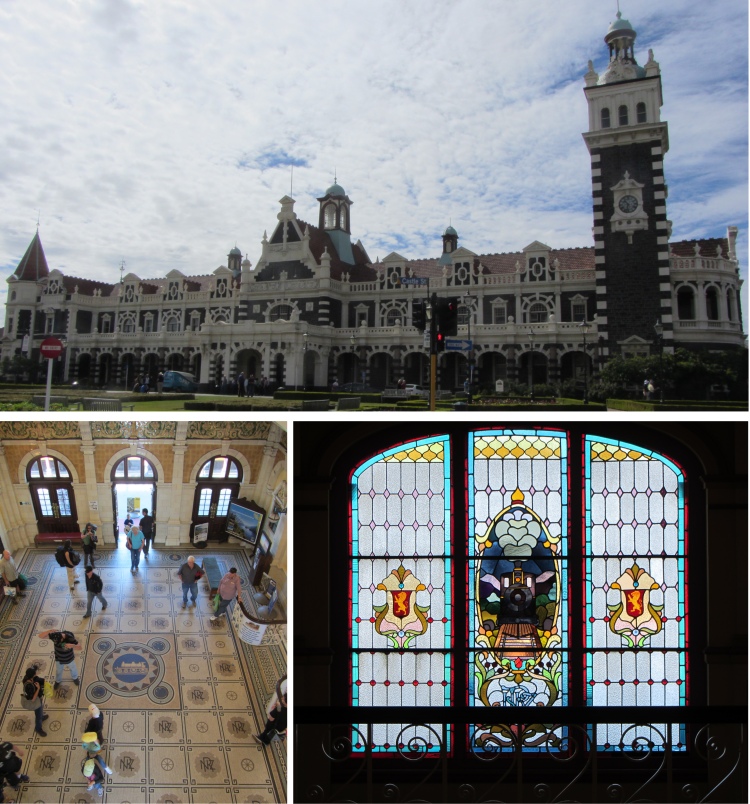
Dunedin Railway Station
|
The 1906 Dunedin Railway Station was a masterpiece: Royal Doulton tiles lined the foyer walls, a mosaic floor echoed the age of steam theme, and brass fittings glistened everywhere. The stained glass windows continued the theme by depicting an approaching train. This really was a little gem, and I could understand why the building had been nominated as the most photographed building in the country. The first floor of the building housed the New Zealand Sports Hall of Fame, celebrating the legacy of more than a century of New Zealand champions, plus an art gallery.
Our guide provided a piece of the history of the station. The architect was George Troup, who seems to have had carte blanche when it came to the design. The stonework was local, the white blocks came from Oamaru, the pink granite columns from Aberdeen, the red roof tiles from Marseilles, and the tiles and mosaics from England. Royalty had passed through this station over the ages. The passenger service stopped with the advent of the car, and the building went into decline. Its outside became a uniform grey, and there was a move afoot to have it demolished. However, once the original colours had been discovered, the building was given a make-over. The original mosaic floors had sunk due to poor foundations supporting it, and so had to be replaced. Royal Doulton were not interested, so a Japanese company did a Chinese copy of the original floor, and a jolly good job they made of it too.
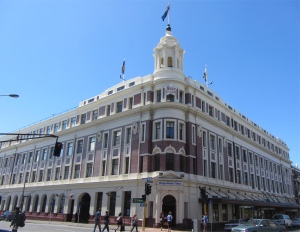
Otago Daily Times Building
|
Today, only goods trains passed through the station, but the Taieri Gorge Railway used the station as its base. The impressive platform was 400m long, and each year the local fashion industry (the university ran fashion design courses and many fashion designers had made Dunedin their home) hosted a fashion parade, using the long platform as a catwalk.
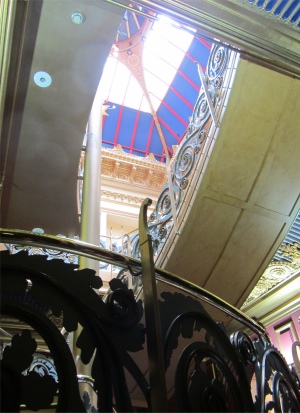
Looking Up to the Casino Skylight
|
We continued our journey past the courts, currently being refurbished. Next door was the old, red brick prison, conveniently connected to the courts by a tunnel. The prison had been ahead of its time, it had included an exercise yard. And conveniently standing next to the prison was the old, red brick police station. The latter two buildings were now empty, currently awaiting a decision on their future.
The nearby Otago Settlers Museum was closed for a year's refurbishment, so we carried on to Queen's Square, Victoria of course. Our guide explained that the land we were standing on was where the first settlers landed, and was the oldest part of the town. Much of the low lying area was actually reclaimed land.
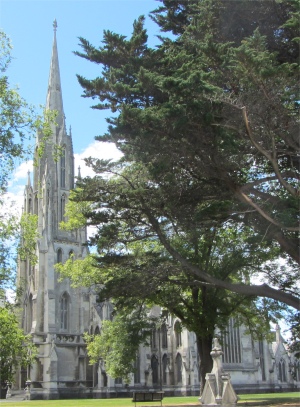
First Church
|
We continued up hill, there are plenty of hills in Dunedin, with our guide pointing out old buildings which had previously been banks, or insurance companies, or Jewish clothing manufacturing factories and outlets. The stock exchange, the first in the country, had moved to another city, and the grand old building had been replaced by a drab modern construction. She took us into the casino with its stunning ornate view up to the skylight, and then we retired for a coffee in a cafe on High Street. When the settlers first landed, the hill that High Street climbed was just bush.
As we sipped our cafe, she showed us old photographs of High Street when it was just a muddy hill with a few wooden shacks on either side of it. Later, a cable car stretched up the hill, and then in the 1950s, the car ousted the cable cars in the city.
The architectural styles I had seen within the city had a remarkable similarity with those I had recently seen in Oamaru, the major difference being the building materials; predominantly volcanic bluestone, which lent a sombre mood to the settlement. I couldn't get over why so many beautiful buildings were now empty and neglected, or had even been pulled down on the pretence of modernity.
"Has New Zealand got the equivalent of the National Trust, or English Heritage, to preserve and protect these old buildings?" I asked our guide. "No, we haven't," she replied. "The train station was restored using public donations, but a lot of these old buildings are at the mercy of their owners." It seemed a common theme of the country's heritage. There is no large organisation with the funding or clout to look after the country's heritage, and old properties get trampled over by greedy developers.
After coffee, we wended our way a little further, passing a building that once had been of stunning design according to photographs, but had now been remodelled into a fish and chip shop. I teased our guide at this juncture. Kiwis pronounce that term as "Fush n' chups", whereas Australians pronounce it as "feesh n' cheeps". She didn't mind the teasing, and gladly owned up to the mispronunciation.

University of Otago Campus
|
Our final port of call was the First Church, a Presbyterian church. This was an impressive building built of stone and brick, with a delicate wooden roof. Glorious stained glass windows allowed dappled coloured light to play on the old original pews. At one time the church-goers rented their seats on the pews, and some of the original plaques indicating that this was the McGregor seating area, or the Burns area etc. were still nailed to the pews. There would be much tutting if folk missed a service; the Scotts were very particular about church and school attendance.
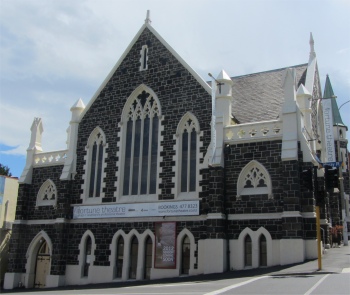
Fortune Theatre
|
At this point, our guide left us to our own devices, and we each went our separate way. I decided to sit down with a mug of coffee, and mull over the history of this town. The Otago region attracted Maori settlers more than four centuries ago. Sealers moved into the area from the beginning of the 19th century, and by the late 1830s, the harbour was an international whaling port. The New Zealand Company purchased land from the local Maori in the early 1840s in order to establish a Scottish settlement, and in 1848 the first wave of migrant ships arrived, led by Captain William Cargill and the Reverend Thomas Burns, nephew of Robbie Burns. A pattern is appearing here: firstly explorers, then exploiters, and finally missionaries. Christchurch had been founded as an Anglican settlement, Dunedin was a Scottish Presbyterian one. The Scottish migrants established a town and stamped the Scottish character upon it, which would endure when English and Irish migrants followed later. It is interesting to note that our guide had explained that although it was a predominantly Scottish town, much of the money to kick start its growth had been English money.
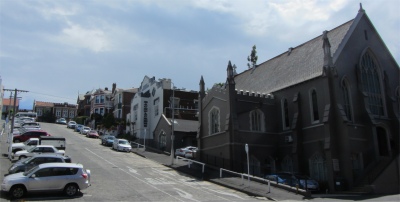
Typical Dunedin Steep Street
|
In 1861, gold was discovered in central Otago, bringing about an expansion of the port, and a doubling of the population in six months, and trebling in three years. With the attendant prosperity, Dunedin became New Zealand's biggest city and the country's industrial and commercial heart. The new-found wealth spurred a building boom, and magnificently-ornate new buildings, many of which still stand today, sprang up in the city with kerosene lighting, freezing and hydroelectric works. In 1879, it was the first city outside the USA to have its own tram system. This was phased out in 1957. With the end of the gold rush in the 1870s, Dunedin was surpassed by other New Zealand cities in importance but remained the South Island's second largest city.
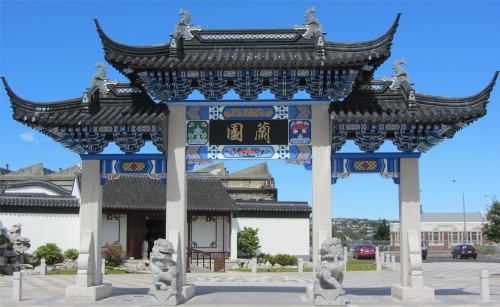
Entrance to the Chinese Gardens
|
Sufficiently refreshed, I took a lazy stroll down to the University of Otago Campus. In 1869 Scottish settlers founded what is the country's oldest and largest university; packed with historic architecture, cafes, bars, art galleries, theatre and New Zealand designer fashion. The imposing old buildings were modelled on Glasgow University, and their associated administration buildings composed of Gothic style bluestone with their clock tower were equally impressive. Now, the university was a massive sprawl with many departments, and some of the more modern buildings having a charm of their own. A small river ran through the campus enhanced the setting. During term time, one fifth of the city's population were students, adding a special vibrancy to this city and contribution to its distinctive culture.
I headed back to the centre of town, passing Cadbury World, and spotting further on Speight's Brewery, established in 1876 and one of New Zealand's oldest breweries. This place was full of very steep hills. A claim to fame for the city was the world's steepest street, Baldwin Street, with a gradient of 1 in 2.66; almost 19 degrees. As part of the Dunedin Summer Festival, an annual "Gutbuster" takes place, with masochistic contestants racing up and down it. Sadly I won't be hanging around to partake in this pleasure.
By now I was suffering architecture overload, so I switched to galleries, ending up at the Public Art Gallery, where I stayed until throwing out time.
I had enjoyed my day of tramping around the streets of Dunedin. The architecture and history was impressive, and the student influence lent vibrancy to the city. The skies were darkening, and the temperature dropping dramatically. I arrived back at the campsite just as the heavens opened.












